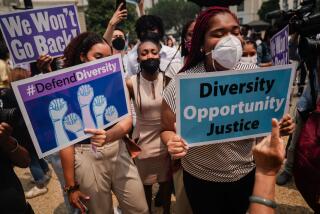Affirmative Action Via the Back Door
- Share via
When the Supreme Court, early in July, declared affirmative action to be a lawful and useful form of redress, the Reagan Administration was mightily peeved. The Administration has taken the position that a job vacancy could never legitimately be held for a black or Latino person or a woman. A month later, that same Administration was holding open the job of U.S. ambassador to South Africa until a black person could be found for it.
The President’s determination to have a black ambassador to Pretoria has been criticized as mere symbolism. But even those of us who oppose the President’s stand on sanctions should be applauding this imaginative bit of affirmative-action casting, especially since it doesn’t exclude sanctions later on. Symbols of this sort do have power to affect the course of events. Affirmative-action programs, if they are successful, have a way of sending messages that times have changed. That is true for police and fire-fighting jobs, law-firm partnerships, carpenter apprenticeships, professorships--and diplomatic assignments.
Who holds what job has always been of high symbolic importance. Hiring women and blacks as police officers sends the message that authority to keep order is no longer to be considered a white male prerogative. Opening the priesthood to women would tell everyone that females and males have the same standing with God.
Getting women and black and Latino people into jobs that have authority, pay well and are looked to for leadership does more than benefit the individuals who get those jobs. When President Reagan chose Sandra Day O’Connor for the Supreme Court, he didn’t just improve the position of one woman lawyer. Her presence there counteracts the tendency, recently documented in a study of the New York courts, to regard and treat women lawyers, litigants and jurors as ninnies, unworthy of respect. The more that minorities and women hold high-status jobs, and perform well in them, the faster such attitudes will fade from the scene.
But, the Reaganites contend, the people hired under affirmative action don’t perform as well in those jobs as the white males who otherwise would have been chosen. If race or sex quotas must be met, the argument goes, the most-qualified person won’t be hired, and productivity will diminish.
Affirmative-action programs, especially badly administered ones, can and do lead to mistakes in hiring or promotion. Sometimes females or blacks who are outright incompetents are appointed. Personnel directors make mistakes, too, even sometimes in the hiring of white males.
Jobs are not always awarded with fine impartiality to the most competent. In the absence of affirmative action, many highly competent people who are not white males are left out. That’s why we need anti-discrimination laws and affirmative-action programs to implement them. The Supreme Court and the lower courts do not proceed on the premise that discrimination does not exist, or is rare, or could be ended by pledges to fair hiring. Judges have heard too many cases in which the testimony has pointed unmistakably to entrenched and stubborn attitudes that denied qualified and competent women and minority people access to the better jobs. Economic research has consistently shown that the big gap in pay and position between blacks and whites, between men and women, cannot be explained away by differences in qualifications.
The opponents of affirmative action give the impression that the alternative is a squeaky-clean process, free of bias, that selects only the best. In reality the alternative to affirmative action in many situations is the continuation of habits, ways of thought, old-boy networks that make only white men look suitable and competent for certain jobs, and make everyone else appear to be unsuitable. The accounting firm with 300 white male partners doesn’t lack women and black accountants who are smart, devoted, trained, experienced. It simply cannot bring itself to see them as leaders, bosses, client-pleasers. Affirmative-action programs help to change such attitudes.
When Harvard University decided that it needed to shoehorn a few black and female scholars onto its faculty, it found some brilliant people to serve, none of whom would have been selected without a conscious effort to find and hire them.
So the President, if he looks hard enough and in the right places, will find a black American who will do the ambassadorial job in South Africa with skill, dignity, and effectiveness. That is the most one can ever ask, in reality, of a selection process. But the fact of the ambassador’s color will be a particular asset, in sending the embattled people of South Africa, blacks and whites, a message of our country’s esteem for the principles of equality. The President will deserve praise for that bit of affirmative-action theatrics. Too bad he refuses to see the symbolic benefits of affirmative-action closer to home.
More to Read
Get the L.A. Times Politics newsletter
Deeply reported insights into legislation, politics and policy from Sacramento, Washington and beyond. In your inbox twice per week.
You may occasionally receive promotional content from the Los Angeles Times.









